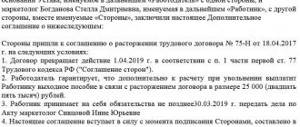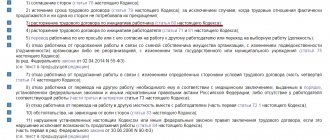Russian labor legislation includes 40 options for terminating a contract, however, in most cases, dismissal still occurs by agreement of the parties (Article of the Labor Code of the Russian Federation No. 78). Obviously, this method of terminating the employment relationship is the least painful for both the employee and the employer, and therefore it is a priority. However, dismissal by agreement of the parties also includes many legal subtleties, which will be discussed in this material.
Dear readers! The articles contain solutions to common problems. Our lawyers will help you find the answer to your personal question
free of charge To solve your problem, call: You can also get a free consultation online.
Features of dismissal
Termination of employment relations by mutual consent of the parties, according to Article 78 of the Labor Code, can be made at any stage of cooperation, including the period of maternity leave or the period of going on vacation. First of all, this is beneficial to the employer, because he has the opportunity to terminate the contract in a shorter period (provided that the employee is paid severance pay). There are also advantages for the employee himself: a) he does not have to comply with the statutory deadline for warning the employer about termination of cooperation; b) severance pay for a certain period of work is paid in full.
Important! The process of terminating a contract under Article 78 of the Labor Code of the Russian Federation is also significantly accelerated due to the fact that there is no need to obtain permission from a trade union organization, which in other cases may prevent an employer from dismissing an employee.
If an employee is forced to quit, Russian labor law forces the employer to cooperate with the union.
Taxes and insurance premiums in connection with the payment of compensation upon dismissal
Upon dismissal from compensation amounts (except for payments for unused vacation), personal income tax is not calculated up to a certain limit. In accordance with the provisions of Art. 217 of the Tax Code of the Russian Federation, as soon as the amount of compensation exceeds 3 times the average monthly earnings, obligations to calculate this tax come into force. For persons who worked in the Far North, this threshold is set at 6 times monthly earnings (letter of the Ministry of Finance of Russia dated October 25, 2019 No. 03-04-06/82289, determination of the Armed Forces of the Russian Federation dated June 16, 2017 No. 307-KG16-19781) .
When issuing a 2-NDFL certificate:
- the amount of compensation is not included in the document if it is not subject to personal income tax;
- if the amount of compensation exceeds the amounts specified in Art. 217 of the Tax Code of the Russian Federation, then in terms of excess it is given with income code 4800.
Read more about the procedure for filling out a certificate in form 2-NDFL in the section “Certificate 2-NDFL in 2021 - 2020 (form and sample)” .
As for income tax, amounts paid as part of dismissal by mutual agreement are classified as labor costs (clause 9 of Article 255 of the Tax Code of the Russian Federation). At the same time, the letter of the Ministry of Finance of the Russian Federation dated April 23, 2019 No. 03-04-05/29191 draws attention to the following conditions for recognizing these payments as expenses:
- payments are determined in the employment or collective agreement, an additional agreement to the employment contract or directly in the agreement on termination of the contract;
- the criteria of Art. 252 of the Tax Code of the Russian Federation.
IMPORTANT! One of the main criteria for recognizing expenses for profit tax purposes, set out in Art. 252 of the Tax Code of the Russian Federation, is economic feasibility.
Therefore, in order to avoid the risk of additional income tax charges, it is worth taking care of a reliable economic justification for payments. First, set payments in reasonable amounts. Secondly, try to justify the dismissal of the employee on this basis. For example, the need to hire a more highly qualified specialist due to the increasing complexity of tasks.
How much dismissal pay can be safely written off as expenses can be found here.
When an employee is dismissed by mutual consent, compensation payments are not subject to insurance contributions within the same limits as established for personal income tax (3 times and 6 times average earnings). And also, by analogy with personal income tax, the exception is compensation paid for unused vacation; this amount is included in the base for calculating insurance premiums. The non-taxable limit is established in paragraph. 6 subp. 2 p. 1 art. 422 Tax Code of the Russian Federation, art. 20.2 of the Law “On compulsory social insurance against accidents at work and occupational diseases” dated July 24, 1998 No. 125-FZ.
Severance pay amount
Article 78 of the Labor Code (like any part of the Labor Code of the Russian Federation) does not provide for a specific amount of compensation that an employee can count on upon dismissal. It is only stated that the maximum amount of compensation cannot exceed three salaries of employees if the dismissed person worked at his workplace for at least 26 weeks. If the company administration refuses to pay compensation (and this was specified in the additional agreement), then in such a situation the dismissed person has legal grounds to start legal proceedings. The additional agreement can be terminated, but according to government regulations, the consent of both parties must be obtained for this.
How to draw up an agreement?
The Labor Code does not indicate in what form an agreement to terminate an employment contract should be concluded (Article 78 of the Labor Code of the Russian Federation).
Since Part 1 of Art. 67 of the Labor Code of the Russian Federation requires that an employment contract be concluded in writing, then the form of the agreement on its termination must be written. The agreement must be drawn up by analogy with an employment contract: in two copies, each of which is signed by the parties . One copy of the agreement must be given to the employee, the other will be kept by the employer. The employee must sign a copy of the agreement kept by the employer to receive his copy. For example, in this form: “I have received a copy of the agreement. Signature, date” (Part 1 of Article 67 of the Labor Code of the Russian Federation).
Possible pitfalls
If we are talking about termination of the relationship between the employee and the employer, then, according to the first provision of Art. 78 of the Labor Code of the Russian Federation, then the entire dismissal process most likely resembles a game of chess, since each side wants to make the most profitable move. The employer wants to dismiss the employee as quickly as possible without possible legal consequences, while the employee himself wants to receive the maximum possible compensation. If the organization is too interested in the employee leaving, then it is quite possible that the organization will pay several salaries more, if this is possible.
Procedure and procedure for terminating an employment contract
Unlike other grounds for termination of an employment contract, dismissal by mutual consent is not regulated in detail in the Labor Code. Therefore, the employee and the employer often do not understand the sequence of actions when terminating the employment relationship.
To avoid labor disputes, it is very important for both parties to know the stages of terminating an employment contract by mutual consent. Let's look at step-by-step instructions for dismissing an employee by agreement of the parties.
Initiation (sending an application)
Both the employee and the employer can initiate termination of the employment contract. Unlike dismissal initiated by one of the parties, here any party to the employment relationship can begin the dismissal process. To do this, it is enough to send the other party a proposal to terminate the employment relationship.
It is best to do this in writing in order to further prove that the dismissal by agreement of the parties was voluntary and mutual. In practice, such a written document is called “Application for termination of an employment contract by agreement of the parties.” However, the name of the document may differ: it is often also called “Proposal to terminate the employment contract by agreement of the parties.”
Let's consider two situations:
- The initiator of dismissal is the employee.
An employee can draw up a written statement (see example) and submit it to the manager in a convenient way. The employee can also personally come to the employer and verbally express his intention to terminate the contract by mutual consent. However, to avoid disagreements, it is recommended to formalize such a declaration of will in writing.
Proposal to terminate the employment contract by agreement of the parties (from the employee)
There are two schools of thought regarding what is best to include in a statement:
- Some lawyers recommend that the employee, when drawing up an application, immediately indicate the desired amount of compensation upon dismissal, the date of termination of the contract and other conditions. However, judicial practice develops as follows: if the employee and the manager do not enter into a written agreement, while the employee’s application indicates the desired date of dismissal (and the employer signed this application), the procedure for dismissal by agreement of the parties is considered to be complied with (Appeal ruling of the Moscow City Court dated March 18, 2016 in case No. 33-9523/2016). In this case, it will be difficult for the employee to withdraw such an application, since the employer’s consent will be required.
- An alternative position is that it is best for the employee to simply notify the manager in writing of the intention to terminate the contract by agreement of the parties. In this case, the employee may change his mind before entering into an agreement.
In any case, the employee independently chooses one or another model of behavior. The employer, in turn, can either agree or refuse his employee’s offer.
- The initiator of dismissal is the employer.
Often, the employer calls the employee and, alone with him, proposes dismissal. There are situations when a manager discusses the termination of a contract with a ready-made agreement, which only lacks the employee’s signature. The employer can also send a written notice to the employee proposing to terminate the employment contract with him (see example).
Proposal to terminate the employment contract by agreement of the parties (from the employer)
Regardless of the circumstances of the offer, the employee has the right to either agree to the terms offered by the employer or refuse. The employee can also partially agree to the terms, that is, make his own changes.
In order to move to the next stage, the employee and his manager must reach a compromise. If an agreement on dismissal is reached, the parties to the employment relationship begin to negotiate the terms of the agreement.
Drawing up an agreement
The next step in dismissal by mutual consent is the conclusion of an agreement. In labor law, such a document is called an “agreement on dismissal / termination of an employment contract by agreement of the parties.”
The agreement must be drawn up in writing , since in case of disagreement regarding the amount of payments upon dismissal, etc., the document will serve as evidence of reaching an agreement regarding all conditions.
The parties may include in the agreement any terms on which they do not disagree. Often, the stage of drawing up an agreement does not look like a negotiation process (the employee and the employer sit opposite each other and discuss the terms).
In most cases, the employer provides the employee with a ready-made text of the agreement. However, this does not mean that the employee is required to sign the document. On the contrary, at this stage the employee has the right to make changes to the text of the agreement, since it will be difficult to change it in the future.
As noted earlier, labor law does not list the mandatory conditions that must be included in the agreement. However, the employee and the employer need to determine the date of termination of the employment contract, since all subsequent stages of termination of the employment relationship will be related to it (see Letter of the Ministry of Labor dated April 10, 2014 N 14-2/OOG-1347).
The provision for payments upon termination of the contract is not mandatory. However, it often influences the decision about the advisability of dismissal. For example, if the payments provided for in the agreement are less than the payments upon termination of the contract on the initiative of one of the parties, then it will be more profitable for the employee to refuse dismissal by mutual consent.
Issuance of an order
When signing the agreement, the parties determine the employee’s last working day, as well as the date of termination of the employment contract (usually they coincide). It is on this day that the manager issues an Order, which can be drawn up either according to a specially developed form or according to the unified T-8 form (see example of an order).
Order to terminate an employment contract by agreement of the parties
The order must contain the following information:
- Full name of the employee, name of the employer;
- Dates - the date of the order, as well as the date of dismissal (the same);
- The norms on the basis of which dismissal occurs - clause 1, part 1, art. 77 Labor Code of the Russian Federation;
- The basis for termination of the contract is a document (agreement or statement);
- Signatures of the employee and employer (or other authorized person).
Important ! There are situations when an employee may not want to sign an order. Therefore, the corresponding statement must be made in the document.
Making an entry in the work book
After reading the order, the employer (or the human resources department) must either make an entry about the dismissal in the work book, or provide information in the electronic work book. Such actions must be carried out on the day of termination of the employment contract.
At this stage, the employee should carefully read what is written in his work book. If he is dismissed by agreement of the parties, then the following must be indicated: “The employment contract is terminated by agreement of the parties, Article 77, part 1, paragraph 1 of the Labor Code of the Russian Federation.”
Entry in the work book upon dismissal by agreement of the parties
Also, a corresponding entry must be made in the employee’s personal card (if there is one).
Issuance of documents and payment
On the day of dismissal, the employer must provide the employee with documents located in the organization (work book, diploma, certificate, etc.), and also make a calculation:
- If the agreement does not stipulate payments upon dismissal, then the employer is obliged to pay wages for the period of time worked, as well as compensation for unused vacation.
- If the agreement specifies payments, the employer must pay all compensation.
Important! Article 140 of the Labor Code of the Russian Federation establishes that the period for settlement with an employee cannot be changed by mutual agreement. Therefore, the manager must pay all amounts on the day of dismissal.
Cancellation of additional agreement
As noted above, dismissal by agreement of the parties (Article 78 of the Labor Code of the Russian Federation) can only take place on the basis of an additional agreement, which is drawn up in accordance with all of the specified recommendations. But there are times when the situation has changed and there is no longer a need to fire an employee. What should the parties to the legal relationship do in this case?
An additional agreement by agreement of the parties can be canceled, but for this one condition must be met - the desire of both parties to the legal relationship.
In a situation where the employee himself wants to return to work, he must submit a written application to the head of the company with such a request. If 14 days have not yet passed since the order was issued, then the employer does not have the right to refuse it. In order for a dismissed employee to be able to resume his or her job duties, it is necessary to issue an order to cancel the additional agreement.
Dismissal by agreement of the parties or by layoff: which is better?
Reduction or dismissal by agreement of the parties? Often, employers offer employees, instead of the required reduction, to resign by agreement of the parties. This is beneficial for the employer because:
- This is the “easiest” of all forms of termination of employment: an employee can be fired at any time, without warning.
- The likelihood of challenging the dismissal in court is minimal.
But what benefits and disadvantages does such dismissal bring to the employee? Agree or not
?
The issue of financial benefits in this case is decisive for the employee. And if the employer wants to simplify his task by dismissing the employee by agreement, he will have to convince the employee with “financial arguments.”
The legislation does not provide for specific rules in this regard, and the employer agrees to this based on considerations of economic feasibility. Therefore, if management offers more favorable conditions compared to the total officially established compensation for reduction (at least three, at most five average monthly earnings), and if the agreement contains additional “beneficial” clauses (for example, if obligations give the employee good recommendations), - dismissal by agreement of the parties will be the best solution.
The main argument that makes dismissal by agreement attractive to an employee is the financial benefits and prospects for further employment. If a laid-off worker wants to receive maximum financial compensation and registers with the employment center, he must not work for at least 60 days in order to receive benefits. Upon dismissal by agreement of the parties, the employee receives all compensation specified in the agreement, regardless of further terms of employment. Therefore, you can find a job immediately after dismissal.
Important:
You should not rely on oral promises; the agreement takes legal force from the moment it is concluded and is not subject to cancellation at the initiative of the dismissed person.
Another commentary on Article 79 of the Labor Code of the Russian Federation
A fixed-term employment contract is terminated upon the expiration of its validity period, of which the employee is warned by the employer at least three calendar days before dismissal, in contrast to the previous wording of the article.
A warning about termination of a fixed-term employment contract must be given in writing. The legislator establishes a general mandatory rule for the employer to warn the employee about the upcoming termination of the employment contract. If there is no written warning from the employer, and the employee continues to work, then the employment contract is considered concluded for an indefinite period (see Article 58 of the Labor Code and commentary thereto). The employment relationship actually continues, but if in the future the parties consider it inappropriate to continue the employment contract, then it can be terminated, but not under Art. 79 TK.
Dismissal of an employee upon expiration of the contract concluded for the duration of the duties of the absent employee does not require such notice.
Parts 2 - 4 of the commented article clarify the moment of expiration of a fixed-term employment contract. An employment contract concluded for the duration of a specific work is terminated upon completion of this work. The legislator links the termination of an employment contract not with its expiration date, but with the deadline for performing specific assigned work (for example, drawing up an accounting report). The fact of dismissal of the employee in this case will be the date on which the work is considered completed (completed).
Part 3 of the commented article provides that an employment contract concluded for the duration of the duties of an absent employee is terminated when this employee returns to work. It must be borne in mind that such an agreement may have a specific period: say, four months or a year and a half, and in the event of an absent employee returning to work early, such an agreement is terminated.
An employment contract concluded for the duration of seasonal work is terminated after a certain period. The grounds for dismissal of an employee will be the end of the season. The list of seasonal work, including individual seasonal work, the implementation of which is possible during a certain period (season) exceeding six months, and the maximum duration of these individual seasonal work are determined by industry (inter-industry) agreements concluded at the federal level of social partnership (see Art. Articles 293 - 296 of the Labor Code and commentary thereto).
Current labor legislation establishes additional guarantees when terminating a fixed-term employment contract, for example for pregnant women. In particular, in the event of expiration of a fixed-term employment contract during the pregnancy of a working woman, the employer is obliged, upon her application and upon provision of a medical certificate, to extend the term of the employment contract until the end of pregnancy. In this case, a pregnant woman is obliged, at the request of the employer (but not more than once every three months), to provide a certificate confirming the state of pregnancy. However, if a woman actually continues to work after the end of pregnancy, then the employer has the right to terminate the employment contract with her due to its expiration within a week from the day the employer learned or should have learned about the end of pregnancy (see Article 261 of the Labor Code and commentary to it).
If it is established during the trial that there have been multiple conclusions of fixed-term employment contracts for a short period of time to perform the same labor function, the court has the right, taking into account the circumstances of each case, to recognize the employment contract as concluded for an indefinite period (see paragraph 14 of the Resolution of the Plenum of the Armed Forces of the Russian Federation dated 17.03. 2004 N 2).
Pros and cons for the employee
Termination of an employment contract has both its positive and negative sides. For clarity, we consider them in the table in relation to both sides of the labor relationship.
| pros | Minuses |
| The initiator can be any party to the labor relationship | There is no control over the legality of dismissal by the trade union (minus for the employee, plus for the unscrupulous employer) |
| You can terminate the contract at any time | A signed agreement cannot be canceled unilaterally |
| There is no mandatory work off for the employee (as in the case of dismissal at the initiative of the employee) | In some cases, employers use this basis to hide staff reductions, etc. |
| An entry in the work book about dismissal by agreement of the parties does not compromise the employee in any way (it does not spoil his resume, as is the case with dismissal for absenteeism, etc.). | It is very difficult to prove in court that the employer forced the employee to sign the agreement |
| The agreement can provide for any conditions, including any compensation |






